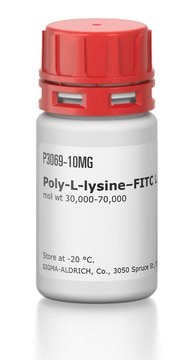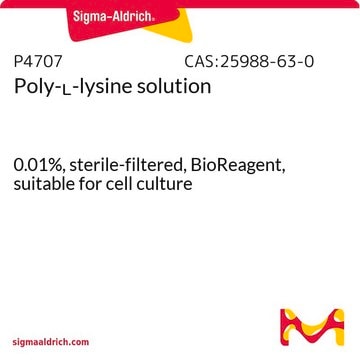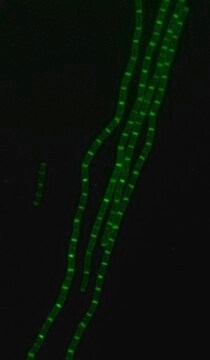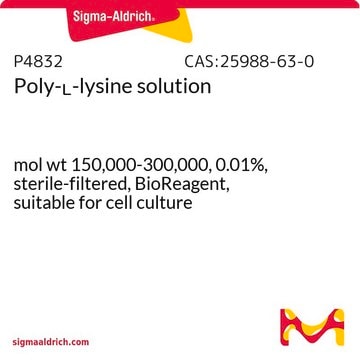The viscosity average molecular weight (Mv) is determined for each lot of this product. However, there is a distribution of molecular weights around that Mv. As a result, the molar concentration is not applicable. The typical degree of polymerization (DP) for this material is approximately 100 and the typical degree of substitution (moles of FITC per mole of lysine) is approximately 0.007 or 7 per 1000; essentially 7 of 10 Poly-L-Lysine molecules contain one FITC label. The concentration of the solution may be most accurately determined by precisely weighing the sample and precisely determining the volume, so that the sample may be reported as mg/mL. The degree of substitution and degree of polymerization are lot specific and reported in the product Certificate of Analysis. Please see the link below to review a sample of lot specific Certificate:
https://www.sigmaaldrich.com/product/sigma/p3543#product-documentation
推薦產品
形狀
powder
品質等級
分子量
precursor poly-L-lysine • HBr 15,000-30,000
15,000-30,000
標籤範圍
0.003-0.01 mol FITC per mol lysine monomer
顏色
yellow to orange
儲存溫度
−20°C
尋找類似的產品? 前往 產品比較指南
其他說明
儲存類別代碼
11 - Combustible Solids
水污染物質分類(WGK)
WGK 3
閃點(°F)
Not applicable
閃點(°C)
Not applicable
個人防護裝備
Eyeshields, Gloves, type N95 (US)
從最近期的版本中選擇一個:
分析證明 (COA)
客戶也查看了
文章
Humankind has utilized protein materials throughout its existence, starting with the use of materials such as wool and silk for warmth and protection from the elements and continuing with the use of recombinant DNA techniques to synthesize proteins with unique and useful properties.
-
ow do you determine the peptide concentration of a small scoop in solution? I am reading the absorbance at 495nm to read the fluorophore but I don't know how to convert that Absorbance value to a meaningful mg/mL or molarity concentration without an e.c.
1 answer-
Helpful?
-
-
How much FITC quantity or weight percentage is present per mg of the mixture? If 10 mg of the product is weighed out, what portion of the weight corresponds to the PLL?
1 answer-
The FITC quantity present per mg of the mixture is 0.016 mg, which corresponds to approximately 1.6% of the weight. If 10 mg of the product is weighed out, the portion of the weight corresponding to the PLL is approximately 9.84 mg.
Helpful?
-
Active Filters
我們的科學家團隊在所有研究領域都有豐富的經驗,包括生命科學、材料科學、化學合成、色譜、分析等.
聯絡技術服務









